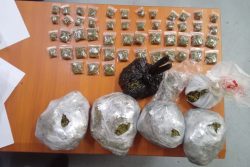Mention was made in last week’s column about the possible need for special treatment for those animals which were companions to the one that was euthanized. Let me quote a colleague, Dr S O’Meara, on the subject:
“During the first few days after a pet has been euthanized, how you treat the remaining pets really depends on their reaction to the loss of the euthanized pet, and on the hierarchies that existed previously and that have now been altered following the loss of one of the pack.
Some animals may seem completely unfazed by the absence of a pet and will not react at all. You can treat these animals just like you always have done, making sure to monitor these pets for any signs of problems (because some pets will be grieving, but not show it very clearly).
 “Pets that are grieving and showing obvious signs of loss can be mollycoddled for a few days, just as you would comfort a person who had lost a loved one. Let the animal have time indoors with the family unit, if it is typically an outside pet; give it lots of pats and hugs; make sure that the animal has a warm, comfortable bed (it will be spending a lot of time on it pining) in a dark, quiet place; make sure to give the pet nice-smelling, tasty, tempting foods to encourage it to eat. You can even give the pet something that has the deceased pet’s smell on it, as a way of bringing comfort to the grieving pet.
“Pets that are grieving and showing obvious signs of loss can be mollycoddled for a few days, just as you would comfort a person who had lost a loved one. Let the animal have time indoors with the family unit, if it is typically an outside pet; give it lots of pats and hugs; make sure that the animal has a warm, comfortable bed (it will be spending a lot of time on it pining) in a dark, quiet place; make sure to give the pet nice-smelling, tasty, tempting foods to encourage it to eat. You can even give the pet something that has the deceased pet’s smell on it, as a way of bringing comfort to the grieving pet.
“Let me hasten to add that this kind of intense comfort-giving should only be carried out for a couple of days, not for a long term, because animals are very quick to pick up on what it is that gets attention from you and they will start to play on it to get treats and pats. It won’t take your animals long to learn that acting stressed or apathetic or whining a lot brings with it comfort rewards.
This could result in a pet developing a learned behavioural problem. The sooner your grieving pets get back into the old routines, the better. “It is of great importance to keep a close eye on are the oldest members of your animal family; e.g. the 17 year-old cat or geriatric dog. Grieving animals may not eat or drink much when they are depressed and, in old animals, especially old animals that are refusing to drink, this lack of water intake can potentially lead to life-threatening medical problems such as decompensation of pre-existing renal failure. For example, old cats with kidney disease need to drink plenty of water to keep their kidneys working and refusal to drink because of depression can cause the kidneys to fail.
“Also be aware of pets that are prone to stress-induced diseases, because the loss of a fellow pet is a genuine source of stress that could set a stress-susceptible animal’s disease condition off. Conditions that might be exacerbated or affected by stress include: feline herpes virus (cat flu), feline herpes virus eye ulcers, feline idiopathic cystitis (FIC), feline lower urinary tract disease (blocked urethras in cats), Addison’s disease, diabetes mellitus and psychosomatic diarrhoea. If your vet has any therapy available to reduce the stress or chances of disease relapse, now is the time to instigate it. For example, animals excessively stressed by the euthanasia of a fellow pet may require calming drugs to help them cope.
“Finally, be aware of the change in pet pack hierarchies (especially dog hierarchies) that may occur after one pet has passed on. If that deceased animal was a dominant animal, you may start to get fighting among your other canine pets as they jostle for status and dominance in the new pack. You will need to adjust your feeding patterns (e.g. who gets food first), and attention-giving patterns (the dominant dog gets attention first) to fit this new order. Ask your vet or an animal behaviouralist for advice.”
Mention is made above of the “hierarchies” which existed in the group, before the dominant alpha dog died. Some amazing behavioural patterns can emerge when one pet dies, especially if he was the top-dog, the alpha male. I recall a case in which the dog next in line in the canine hierarchy of the home jumped up on the couch frequented by the alpha male, as soon as the latter was buried. The second-in-command decided he was now top dog and would not move from the couch, not for food, not in response to any enticement.
When the owner tried to physically move him, he growled and bared his teeth in a most unfriendly manner. Only much later, when he had established his credentials of leadership did he move from the couch and would not let any of the other dogs go near it.
Stemming from the above, the question emerges whether the care-giver should allow the other pet(s) to see the dead body. In my opinion, it is often a good idea, if you do bring the other pets in (eg into the vet clinic or house) to view the body and sniff it over. I do believe that animals have a concept of death and that viewing the body does give these remaining pets some form of closure. Otherwise, they might just think that the ‘other pet’ has gone missing, and they may search for it and fret for it.
Quickly, in passing, allow me to document that, relative to a reference made in the column of October 26, 2014 (not November 2, 2014, as stated by Ms Manbodh), Ms Manbodh was not the actual person who held the bundle of kittens under water to kill them, nor was this statement made in the said column.
So, now I think that have exhausted this topic of euthanasia and all aspects pertaining thereto. Next week we’ll start with a new series ‘Pet Geriatrics.’
Please implement disease preventative measures (vaccinations, routine dewormings, monthly anti-heartworm medication, etc) and adopt-a-pet from the GSPCA’s Animal Clinic and Shelter at Robb Street and Orange Walk, if you have the wherewithal to care well for the animals. Do not stray your unwanted pets, take them to the GSPCA’s Clinic and Shelter instead. If you do not wish your pet to have puppies or kittens, you may exploit the GSPCA’s free spay and neutering programme. If you see anyone being cruel to an animal, or if you need any technical information, please get in touch with the Clinic and Shelter by calling 226-4237.








